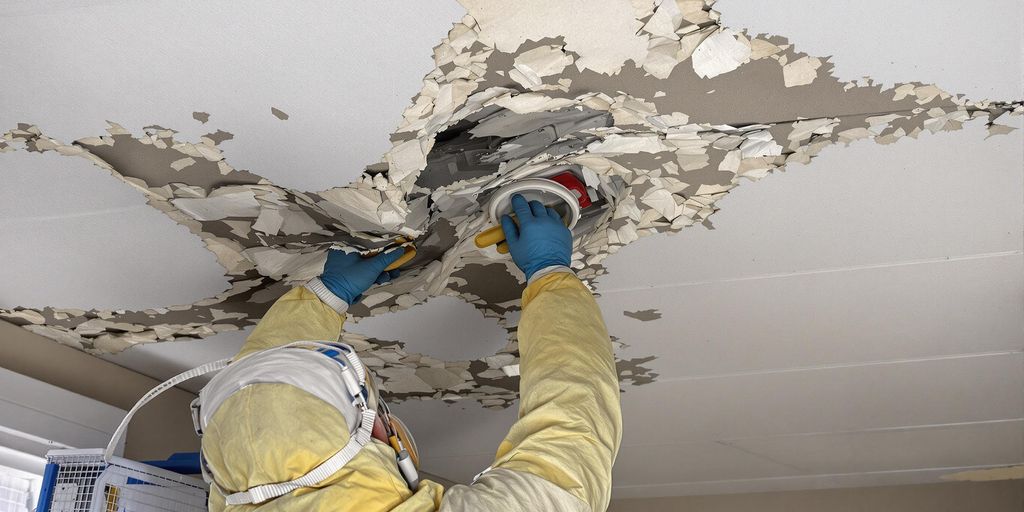Size and Scope of the Project
The overall size of the asbestos-affected area plays a huge role in determining costs. Larger spaces, like entire floors or multiple rooms, demand more labor, equipment, and time. Smaller projects, such as isolated spots on a single wall, naturally cost less. However, keep in mind that even small areas might involve extensive preparation, especially if they’re in sensitive zones like a rehab facility or a treatment center.
Location of Asbestos Materials
Where the asbestos is located can significantly impact removal costs. Easily accessible areas, such as open walls or ceilings, are less expensive to handle. On the other hand, hard-to-reach locations like attics, pipes, or beneath flooring require specialized tools and safety measures, which drive up the price. If asbestos is found in a rehab facility, the need for minimal disruption can further complicate and increase costs.
Type of Asbestos Present
Different types of asbestos materials come with varying removal challenges. For instance, friable asbestos, which crumbles easily, poses a higher health risk and requires stricter safety protocols. Non-friable asbestos, while slightly easier to manage, still demands professional handling. The type of asbestos often dictates the level of containment and treatment required, directly affecting the overall expense.
Understanding the Types of Asbestos Materials
Common Asbestos-Containing Materials
Asbestos was widely used in various construction and industrial products due to its heat resistance and durability. Common materials include:
- Insulation: Often found in attics, walls, and around pipes.
- Flooring materials: Vinyl tiles and adhesives may contain asbestos.
- Roofing and siding: Frequently used in shingles and cement-based products.
Recognizing these materials is the first step in addressing potential asbestos issues.
Health Risks Associated with Each Type
There are six main types of asbestos, each with unique health risks. Here are the most common:
- Chrysotile (White Asbestos): The most prevalent type, found in roofs, ceilings, and walls. Prolonged exposure can lead to lung scarring and other respiratory issues.
- Amosite (Brown Asbestos): Common in cement sheets and pipe insulation, it has strong, heat-resistant fibers that are easily inhaled.
- Crocidolite (Blue Asbestos): Known as the most dangerous type, its brittle fibers can cause severe lung diseases, including mesothelioma.
The other types—Actinolite, Tremolite, and Anthophyllite—are less common but still hazardous, especially when disturbed.
Regulations Governing Asbestos Use
Strict regulations exist to minimize asbestos exposure risks. In the United States:
- The Environmental Protection Agency (EPA) oversees asbestos handling and disposal.
- State and local laws may impose additional rules, particularly for demolition or renovation projects.
- Non-compliance can result in heavy fines and penalties, emphasizing the need for professional intervention.
Understanding these materials and their risks is crucial for safety, whether you’re planning a renovation or managing addiction rehab facilities.
Cost Variations by Location of Asbestos
Interior vs. Exterior Removal Costs
The cost of asbestos removal can vary significantly depending on whether the material is found inside or outside the property. Interior asbestos, such as in walls, ceilings, or flooring, often requires more meticulous preparation, including sealing off rooms and using specialized equipment to prevent fibers from spreading. This can make it more expensive than exterior removal, where the open environment reduces containment needs. For instance, removing asbestos from an exposed outdoor pipe may cost less than dealing with a similar pipe hidden within a basement wall.
Challenges in Hard-to-Reach Areas
Hard-to-reach locations, like attics, crawl spaces, or areas behind structural components, tend to drive up costs. These spots often require additional labor, demolition, and safety measures to access and safely remove asbestos. For example, removing asbestos from pipes running beneath floorboards could involve tearing up the flooring, sealing off multiple rooms, and setting up negative air pressure systems. This extra effort and equipment usage directly increase the overall expense.
Regional Differences in Pricing
Your geographical location plays a big role in asbestos removal costs. Urban areas generally have higher prices due to increased labor rates, stricter local regulations, and higher disposal fees. In contrast, rural areas might offer lower costs but could lack nearby certified professionals, leading to added travel expenses. Additionally, state and local permits for asbestos removal can range from $50 to $100, while disposal fees vary between $10 to $50 per cubic yard. These differences highlight how location-specific factors can significantly influence the total cost.
The Role of Encapsulation in Asbestos Management
What Is Encapsulation?
Encapsulation is a method used to manage asbestos-containing materials (ACMs) without removing them entirely. It involves applying a specialized liquid sealant to bind asbestos fibers together, significantly reducing the risk of fiber release into the air. This process is particularly effective when the asbestos materials are intact and not prone to frequent disturbance. By sealing the material, encapsulation creates a protective barrier, making it safer for building occupants.
Cost Comparison: Encapsulation vs. Removal
When it comes to managing asbestos, encapsulation is generally a more cost-effective option compared to removal. The process eliminates the need for demolition and disposal, which are significant cost drivers in removal projects. Encapsulation typically costs between $2 and $6 per square foot, while removal can be substantially more expensive. Additionally, the sealant used for encapsulation, priced at about $115 per gallon, further underscores its affordability. However, while encapsulation saves money upfront, it may not be a permanent solution, as the material still contains asbestos and could require future maintenance.
When Encapsulation Is a Viable Option
Encapsulation is most suitable in cases where the asbestos-containing material is in good condition and located in areas with minimal risk of disturbance. For example, it can be used on asbestos insulation in hard-to-reach spaces or on surfaces that are not subject to regular wear and tear. However, it may not be appropriate for materials that are already damaged or in areas slated for renovation. A thorough assessment by a certified asbestos professional is essential to determine if encapsulation is the right choice. For more information on the encapsulation process, refer to this guide.
Breakdown of Asbestos Removal Costs
Labor and Equipment Expenses
Labor and equipment are often the biggest contributors to asbestos removal costs. Certified professionals must use specialized tools and protective gear to safely handle the material. This ensures that hazardous fibers are contained and do not pose a risk to health. Expect labor costs to vary depending on the project’s complexity and the time required for completion. Equipment expenses, including negative air machines and HEPA vacuums, also add to the final bill.
Permit and Disposal Fees
Handling asbestos legally requires proper permits and adherence to Environmental Protection Agency (EPA) guidelines. Permit costs typically range from $50 to $100, depending on your location. Disposal fees for asbestos materials can run between $10 and $50 per cubic yard. These costs ensure compliance with environmental standards and safe waste management.
Additional Costs for Repairs
Once asbestos-containing materials are removed, repairs may be necessary to restore the affected areas. This could include replacing drywall, flooring, or insulation. Costs for these repairs vary widely, but they are a crucial part of the process to ensure the property is safe and functional. For example, encapsulation—a less invasive alternative to full removal—may also be considered in some cases, costing 15-25% less than removal. However, Serenity at Summit emphasizes that full removal is often the safer, more permanent solution.
The Importance of Professional Asbestos Testing
Testing Methods and Costs
Professional asbestos testing involves specialized techniques to identify the presence of asbestos in materials. Certified experts may use polarized light microscopy (PLM) or transmission electron microscopy (TEM) to analyze samples. These methods ensure accurate results that DIY kits simply can’t match. Costs for professional testing vary, often ranging from $250 to $800, depending on the number of samples and the complexity of the analysis. While this might seem pricey, it’s a small investment for the peace of mind it provides.
Why DIY Testing Is Not Recommended
DIY testing might appear cost-effective, but it comes with significant risks. Handling asbestos-containing materials without proper equipment can release harmful fibers into the air, endangering your health and that of others. Additionally, DIY tests lack the precision of professional methods, leading to unreliable results. In many cases, local regulations prohibit untrained individuals from disturbing asbestos materials, making professional testing not just safer but often legally required.
Choosing a Certified Testing Professional
When selecting a professional for asbestos testing, look for certifications and experience. A qualified expert will follow strict protocols to minimize exposure risks and ensure compliance with regulations. Key factors to consider include:
- The professional’s familiarity with local and state asbestos laws.
- Their use of accredited laboratories for sample analysis.
- Transparent pricing and clear communication about the process.
Hiring a certified tester ensures that the job is done safely and thoroughly, safeguarding both health and property.
Legal and Environmental Considerations
EPA Guidelines for Asbestos Removal
The Environmental Protection Agency (EPA) has outlined strict rules for asbestos removal to protect public health and the environment. These regulations are non-negotiable and must be followed to avoid severe penalties. For instance, contractors are required to use specialized equipment and follow specific procedures to safely remove and dispose of asbestos-containing materials. Additionally, facilities like Evoke Wellness must adhere to these guidelines to ensure a safe environment for individuals undergoing rehab or other treatments.
State and Local Regulations
State and local governments often have additional laws that go beyond federal requirements. These can include:
- Mandatory notification to local authorities before starting asbestos removal.
- Specific licensing and certification requirements for contractors.
- Limits on the types of disposal sites that can accept asbestos waste.
Understanding these local rules is crucial for compliance and for avoiding unnecessary delays or fines.
Penalties for Non-Compliance
Failing to comply with asbestos regulations can result in hefty fines, project shutdowns, or even legal action. In some cases, property owners may also be held liable if they knowingly ignore these laws. This is why hiring certified professionals who are knowledgeable about both federal and local regulations is essential. Their expertise ensures that everything is done by the book, minimizing risks for everyone involved.
Cost of Common Asbestos Abatement Add-Ons
Repairing Asbestos-Containing Materials
When asbestos-containing materials like siding or drywall are damaged, repairs can sometimes be an alternative to full removal. The cost to repair asbestos siding typically ranges from $700 to $5,000, depending on the size of the area and the specific type of repair needed. For smaller areas, patching or sealing may be sufficient, while larger sections might require partial replacement. It’s essential to consult a professional to determine whether repairs are legally and structurally viable in your region.
Replacing Removed Materials
Once asbestos is removed, the area must often be restored with new materials. Replacement costs vary widely based on the type of material being installed. For example:
- Drywall replacement averages $3 per square foot.
- Replacing air ducts can cost around $3,500.
- Roofing replacement is one of the pricier options, averaging $9,250.
These costs are separate from asbestos removal expenses and should be factored into the overall project budget.
Additional Safety Measures
To ensure a safe environment during and after asbestos abatement, additional safety measures might be necessary. These can include:
- Setting up negative air pressure systems to prevent contamination.
- Using specialized sealants for encapsulation, which cost between $2 and $6 per square foot.
- Conducting post-removal air quality testing to confirm the absence of asbestos fibers.
While these measures add to the overall cost, they are critical for protecting health and complying with regulations. For example, encapsulating asbestos is often a cost-effective solution when removal isn’t required by law, saving up to 25% compared to full removal.
How to Choose a Certified Asbestos Removal Contractor
Key Qualifications to Look For
When selecting an asbestos removal contractor, it’s essential to verify their qualifications. Look for professionals with the necessary certifications and licenses required by your state or local jurisdiction. For example, in New York, contractors must hold an Asbestos Handler Certification. Ensure they are familiar with OSHA and EPA standards, as these regulations govern safe asbestos handling.
Additionally, check if the team is trained and experienced in asbestos abatement. Ask how many workers will be assigned to your project and confirm their certifications. Contractors with a solid track record and positive reviews are more likely to complete the job safely and efficiently.
Questions to Ask Before Hiring
Before hiring, ask these critical questions:
- What is the estimated timeline for the project, including start and completion dates?
- Can you explain your removal and cleanup process? How will you contain the area and dispose of contaminated materials?
- Do you handle repairs and replacements after removal, or will I need to hire another company?
These questions will help you gauge the contractor’s professionalism and ensure they can handle the job comprehensively.
Verifying Licenses and Certifications
Always verify the contractor’s credentials. Request to see their licenses and certifications to confirm they are authorized to perform asbestos removal in your area. Some states have online databases where you can check the validity of a contractor’s license.
For added assurance, consider comparing quotes and reviews from multiple professionals. Compare quotes and select the best asbestos abatement professionals in New York, NY to find contractors with verified reviews. Doing your homework upfront can save you from costly mistakes and ensure the job is done right.
Long-Term Implications of Asbestos Removal
Impact on Property Value
Removing asbestos from a property can significantly influence its market value. Homes or buildings that are free of hazardous materials are generally more attractive to buyers. This is especially true for families concerned about health risks. On the flip side, properties with unresolved asbestos issues may see reduced demand, as potential buyers factor in the cost and effort of removal. For sellers, addressing asbestos concerns before listing can make a property more competitive in the real estate market.
Health Benefits of Removal
Asbestos poses severe health risks when its fibers become airborne and are inhaled. Diseases like mesothelioma, lung cancer, and asbestosis are directly linked to asbestos exposure. By removing asbestos, property owners can create a safer environment, eliminating the risk of future exposure. This is particularly important for families with children or elderly members, as they are often more vulnerable to health complications. Long-term health peace of mind is an invaluable benefit of professional asbestos removal.
Preventing Future Contamination
Effective asbestos removal not only addresses current issues but also prevents future contamination. Poorly managed asbestos materials can deteriorate over time, increasing the likelihood of fibers being released into the air. By opting for professional removal, property owners ensure that their homes or buildings remain safe for years to come. Additionally, proper disposal methods, as required by regulations, help protect the surrounding environment from contamination.




